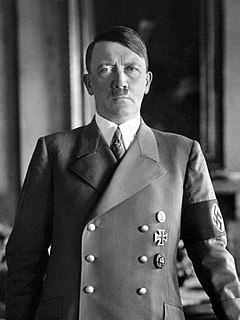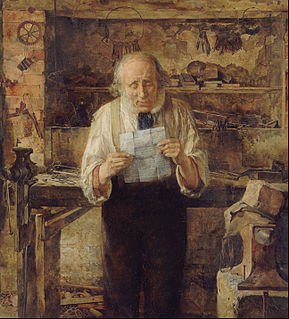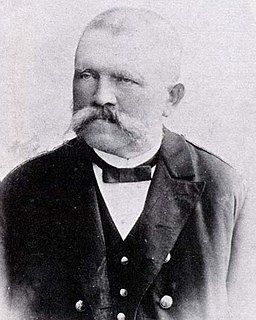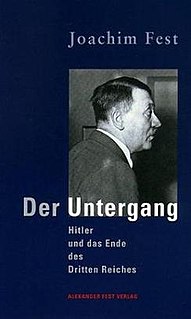Hitler's Letters and Notes is a book by Werner Maser. It is a collection of Adolf Hitler’s personal correspondence and private notations with comments by Maser. It reproduces photo-facsimiles of the handwritten original documents, with translations thereof, from the age of 17 until his death. Maser contends that the book casts new light onto the development of Hitler’s political philosophy.
Werner Maser was a German historian, journalist and professor at the Martin Luther University of Halle-Wittenberg. Werner was the first historian to claim that the Hitler Diaries were forgeries.

Adolf Hitler was a German politician and leader of the Nazi Party. He rose to power as Chancellor of Germany in 1933 and later Führer in 1934. During his dictatorship from 1933 to 1945, he initiated World War II in Europe by invading Poland in September 1939. He was closely involved in military operations throughout the war and was central to the perpetration of the Holocaust.

A letter is one person's written message to another pertaining to some matter of common concern. Letters have several different types: Formal letters and informal letters. Letters contribute to the protection and conservation of literacy. Letters have been sent since antiquity and are mentioned in the Iliad. Both Herodotus and Thucydides mention letters in their histories.
It was first published in German as Hitlers Briefe und Notizen: sein Weltbild in handschriftlichen Dokumenten in 1973. [1] Heinemann (London) published a slightly adapted translation (by Arnold Pomerans) as a 390-page hardcover in 1974, [2] followed by Harper & Row in the United States. [3] Bantam Books released a paperback version in 1976. [4]
Arnold Julius Pomerans was a German-born British translator.
Bantam Books is an American publishing house owned entirely by parent company Random House, a subsidiary of Penguin Random House; it is an imprint of the Random House Publishing Group. It was formed in 1945 by Walter B. Pitkin, Jr., Sidney B. Kramer, and Ian and Betty Ballantine, with funding from Grosset & Dunlap and Curtis Publishing Company. It has since been purchased several times by companies including National General, Carl Lindner's American Financial and, most recently, Bertelsmann; it became part of Random House in 1998, when Bertelsmann purchased it to form Bantam Doubleday Dell. It began as a mass market publisher, mostly of reprints of hardcover books, with some original paperbacks as well. It expanded into both trade paperback and hardcover books, including original works, often reprinted in house as mass-market editions.
This page is based on this
Wikipedia article Text is available under the
CC BY-SA 4.0 license; additional terms may apply.
Images, videos and audio are available under their respective licenses.

Mein Kampf is a 1925 autobiographical book by Nazi Party leader Adolf Hitler. The work describes the process by which Hitler became antisemitic and outlines his political ideology and future plans for Germany. Volume 1 of Mein Kampf was published in 1925 and Volume 2 in 1926. The book was edited by Hitler's deputy Rudolf Hess.

Dietrich Eckart was a German journalist, playwright, poet, and politician who was one of the founders of the Deutsche Arbeiterpartei, which later evolved into the Nazi Party (NSDAP). He was a key influence on Adolf Hitler in the early years of the Nazi Party and was a participant in the 1923 Beer Hall Putsch.

SS-Oberführer Ernst Boepple was a Nazi official and SS officer, serving as deputy to Josef Bühler in occupied Poland during World War II and the Holocaust, who was executed for war crimes.

Alois J. Hitler Sr. was an Austrian civil servant and the father of German dictator and leader of the Nazi Party, Adolf Hitler.
Maria Anna Schicklgruber was the mother of Alois Hitler, and the paternal grandmother of Adolf Hitler.
Johann Georg Hiedler was considered the officially accepted paternal grandfather of Adolf Hitler by Nazi Germany. Whether Johann Georg was in fact Hitler's biological paternal grandfather is disputed by modern historians.

Hermann Rauschning was a German conservative revolutionary who briefly joined the Nazi movement before breaking with it. In 1934, he renounced Nazi Party membership and in 1936 emigrated from Germany. He eventually settled in the United States and began openly denouncing Nazism. Rauschning is chiefly known for his book Gespräche mit Hitler in which he claimed to have had many meetings and conversations with Adolf Hitler.

Hans Mommsen was a German historian, known for his studies in German social history, and for his functionalist interpretation of the Third Reich, especially for arguing that Hitler was a weak dictator. He was a member of the Social Democratic Party of Germany.
The term Hitler oath — also often referred to in English as simply the Soldier's Oath or Soldiers' Oath — refers to the oaths of allegiance, sworn by the officers and soldiers of the German Armed Forces and civil servants of Nazi Germany between the years 1934 and 1945. The oath pledged personal loyalty to Adolf Hitler in place of loyalty to the constitution of the country.

Brigitte Hamann was a German-Austrian author and historian based in Vienna.

Heinrich "Heinz" Hitler was the son of Alois Hitler, Jr. and his second wife Hedwig Heidemann. He was also a nephew of Adolf Hitler, who reportedly called Heinz his "favorite nephew". Heinz was a strong supporter of the Nazis and when World War II began, he joined the Wehrmacht and served on the Eastern Front. He was captured by Soviet troops and died in prison in February 1942.

Inside Hitler's Bunker: The Last Days of the Third Reich is a book by historian Joachim Fest about the last days of the life of Adolf Hitler, in his Berlin Führerbunker in 1945.
Walter Frank, also known by the pseudonym Werner Fiedler was a Nazi historian, notable for his leading role in anti-Semitic research.
Jean-Marie Loret was a French railway worker and allegedly Adolf Hitler's illegitimate son. According to Loret, in 1948 his mother revealed to him shortly before her death that the "unknown German soldier" with whom she'd had an affair during World War I was Adolf Hitler.
A maser is a device that produces coherent electromagnetic waves.
Leo Rudolf Raubal Jr. was a teacher, soldier and manager. He was a nephew of Adolf Hitler.
The psychopathography of Adolf Hitler is an umbrella term for psychiatric literature that deals with the hypothesis that the German Führer and Reichskanzler Adolf Hitler suffered from mental illness. Both during his lifetime and after his death, Hitler has often been associated with mental disorders such as hysteria, megalomania or paranoid schizophrenia. Psychiatrists and psychoanalysts who have diagnosed Hitler as having mental disturbance include well-known figures such as Walter C. Langer and Erich Fromm. Other researchers, such as Fritz Redlich, have concluded that Hitler probably did not have these disorders.
Henrik Eberle is a German historian. During the first decade of the twenty-first century he came to prominence beyond the confines of the German academic community with compilations, books, articles and interviews concerned with Adolf Hitler. Some of these have been translated into English.

Nazi architecture is the architecture promoted by the Third Reich from 1933 until its fall in 1945. It is characterized by three forms: a stripped-down neoclassicism ; a vernacular style that drew inspiration from traditional rural architecture, especially alpine; and a utilitarian style followed for major infrastructure projects and industrial or military complexes. Nazi ideology took a pluralist attitude to architecture; however, Adolf Hitler himself believed that form should follow function and wrote against "stupid imitations of the past".











